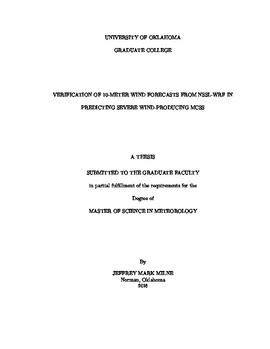| dc.description.abstract | Predicting convective winds associated with mesoscale convective systems (MCSs) remains a major challenge for operational severe weather forecasters. To assess the performance of the Weather Research and Forecasting Model run by the National Severe Storms Laboratory (NSSL-WRF) in forecasting severe wind-producing MCSs between 2012 and 2014, a climatology of these MCSs was developed. Severe wind-producing MCSs were first manually identified by finding swaths of severe wind reports caused by MCSs through inspection of radar reflectivity structure to ensure organized convective mode. To objectively identify severe wind-producing MCSs using an object-based approach, storm reports were filtered based on nearby radar reflectivity. A variety of subsets of severe wind reports were also used. Reports were converted to spatial probabilities via Gaussian smoothing so that objects could be identified. Objects were identified using the Method for Object-based Diagnostic Evaluation (MODE) by testing various minimum intensity and area thresholds to determine which thresholds most accurately matched the manually identified severe wind-producing MCSs. Objects identified based on radar-filtered storm reports most accurately matched manually identified severe wind-producing MCSs. This allowed for development of an object-based climatology of severe wind-producing MCSs. This climatology shows a maximum of severe wind-producing MCSs near the Ohio River Valley with another relative maximum on the Georgia-Alabama border. All identified severe wind-producing MCSs occurred east of the Rocky Mountains. Severe wind-producing MCSs occurred most often in June and least often in November.
Daily maximum 10 m wind forecasts for the 24 hours beginning at 12Z (i.e., f12-f36) were generated from 0000 UTC NSSL-WRF hourly maximum 10 m wind fields. The same smoothing and radar filtering (with simulated reflectivity) that was applied to storm reports was also applied to various forecast daily maximum 10 m wind thresholds between 15 kt and 60 kt. The same intensity and size thresholds were applied to both forecast and observation fields in identifying objects. Forecasts were then verified both on a grid-point-by-grid-point basis, on a grid-based basis using MODE, and on an object-matching basis using MODE. Object-matching utilizes a fuzzy logic algorithm to match forecast and observed objects. Grid-point verification yielded no useful results, with a high number of false alarms dominating any signal. Across a range of wind speed thresholds, the 10 m wind field has a critical success index of around 0.07 when using grid-based verification using MODE and around 0.15 when using MODE object-based verification. Lower wind speed thresholds over-forecast severe wind-producing MCSs and approach a probability of detection (POD) near 100\% for very low wind speed thresholds. As wind speed thresholds increase, the POD decreases sharply without much improvement in the false alarm ratio (FAR). For very high wind speed thresholds, very few events are forecast, so both POD and FAR are low. Though the lower thresholds have slightly lower CSIs than higher thresholds, the large increase in POD with a small penalty in FAR suggests that the lower thresholds may be of more utility to forecasters. | en_US |
